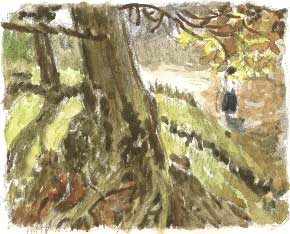
|
A Study of TreesWednesday, 2nd April 2003, West Yorkshire |
![]()
![]()
![]()
![]() Rocks | History |
Workshop |
Links | Home
Page
Rocks | History |
Workshop |
Links | Home
Page
![]()
 'Study of Trees', my sketch , after Constable. |
C E Leslie on Constable |
There are plenty of the better known paintings in the current exhibition, Constable, A breath of fresh air, at the Millennium Galleries, Sheffield, but it's this informal sketch, A Study of Trees with a Figure Beside Them, c. 1821, that I decide to look at in more detail by making a postcard-sized pencil and watercolour sketch (above) from the oil on paper original which is closer to A4 size. By the way, those wobbly margins are the torn edges of the original sheet of paper - thankfully not covered by a mount - that Constable used.
It's been said that John Constable (1776-1837) was ahead of his time in his paintings even though his view of the countryside was conservative. The Leaping Horse caused something of a sensation when exhibited in Paris. Constable was delighted but said that he had no desire to visit Paris to capitalise on his success.
This Study of Trees reminds me of the work of some of the post-impressionists. There's a touch of Van Gogh in it's mood (in Van Gogh's version the trees might be bending in weariness at the end of a long day of toil), of Cezanne in the emphasis on structure around the roots but most of all it reminds me of the kind of folksy rural pieces that Gaughin painted in Brittany.
The impressionists were inspired in their compositions by Japanese prints that became available at that time in France. This diagonal composition has a Japanese feel to it. I feel that there's a graphic quality in the treatment of space: as if space has become a design element in the painting; it doesn't look as if Constable was going out of his way to create an illusion of space. Was Constable familiar with Oriental art? Chinoiserie was in fashion, England was already on its way to becoming a nation of tea drinkers, so I suppose that it's a possibility.
'The Sun is God'
Looking around the exhibition there isn't the 'wow' factor that you'd get with a Turner show. I don't think that Constable intended to overawe the viewer by evoking the sublime as Turner did. But this painting tackles in a gentle way what Turner would have achieved in a wide-screen cinematic fashion: the light source lies within the painting. The low sun is hidden by the central tree, as you can tell by following back the radiating shadows of the trees and the woman.
Perhaps this is a variation on Turner's reported last words; 'The Sun is God'. To judge by the intensity with which the more down-to-earth Constable observed trees and recreated them on canvas, their presence in the landscape verged on the numinous.
The Figure Beside Them
It's typical that Constable should have included the figure.
With my interest in the natural world I'd probably have considered the
passing woman a distraction from this little corner of wilderness and
I'd have painted the track after she'd gone! She's not just there to balance
the composition with colour and interest; Constable depicted a real working
landscape in his paintings that would have been incomplete without the
presence of the rural workers who created it.
![]()
![]() Next page | Previous page | This
day last year | This month |
Nature Diary |
Home
Page
Next page | Previous page | This
day last year | This month |
Nature Diary |
Home
Page
![]()